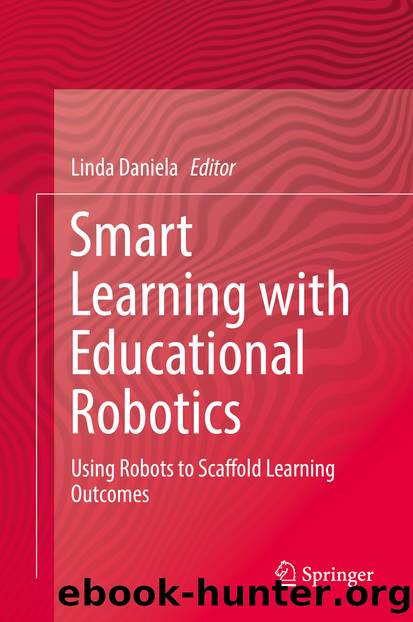Smart Learning with Educational Robotics by Unknown

Author:Unknown
Language: eng
Format: epub
ISBN: 9783030199135
Publisher: Springer International Publishing
Fig. 6.5Preliminary solution (left) and distance measurement procedure (right)
The third block in the program displayed in Fig. 6.5 is a “wait - secs” block, which is a basic block in any programming language and has the effect of pausing the program a predefined time. This time can be an integer or decimal value, and it is important that students understand this difference. The fourth block is, again, a movement block, in this case “run forward at speed 0”, which makes the robot stop. So, once all the blocks are clear, the teacher must carry out an overall explanation of the program logic before students try it: the robot starts moving forward at speed 100, and 1 second later it stops.
To execute this particular program, students must first know how to download the program to the robot using the USB cable or by Bluetooth. This is part of the Robotician role in the group who, in addition, must put the robot on the floor and leave free space in front of it. Moreover, they must fix a measuring tape to the floor and make the robot move next to it, as displayed in Fig. 6.5 right. After executing the program, the robot moves straight for 1 second at a speed of 100, and the students must write down the distance covered by the robot in their notebooks. In this specific case, the distance covered by the mBot was about 5 cm. It is important that the teacher emphasizes that the measurement must be reliable, so the robot must start in the zero value of the tape, and they must be precise with the measurement of the final position. Moreover, the program execution should be carried out more than once in order to avoid punctual fluctuations. All of these tips are very important to introduce students to the relevance of being technically formal.
Next, students had to measure the box sides with the measuring tape and annotate them again. Considering the distance covered by the robot when executing the program shown in Fig. 6.5, and without changing the speed, students had to adjust the time the robot moves in the “wait – secs” block in order to make it advance these two distances (in the case the box is not a rectangle but a square, they will have only one distance). Students at this level know the mathematical concept of rule of three, so instead of trying different time values, they have to calculate the right one, put it on the wait block, and test if the calculation was right. Specifically, for a box of 22 × 22 cm side:5 cm → 1 second
Download
This site does not store any files on its server. We only index and link to content provided by other sites. Please contact the content providers to delete copyright contents if any and email us, we'll remove relevant links or contents immediately.
The Rise and Fall of Senator Joe McCarthy by James Cross Giblin(5228)
Paper Towns by Green John(5088)
The Giant and How He Humbugged America by Jim Murphy(3395)
The Science Book (Big Ideas Simply Explained) by DK(3233)
Eleanor & Park by Rainbow Rowell(3061)
The President Has Been Shot!": The Assassination of John F. Kennedy by Swanson James L(3049)
The Rape Of Nanking by Iris Chang(2774)
Merriam-Webster's Collegiate Thesaurus, Second Edition by Merriam-Webster Inc(2710)
Harry Potter and the Deathly Hallows (7) by J.K. Rowling(2640)
Ancient Worlds by Michael Scott(2622)
Beautiful Oblivion by Jamie McGuire(2569)
Eligible by Curtis Sittenfeld(2548)
Dork Diaries 12 by Rachel Renée Russell(2329)
Sharp Objects by Gillian Flynn(2233)
The Unlikely Pilgrimage of Harold Fry by Rachel Joyce(2217)
Frankly, Frannie by AJ Stern(2169)
The Astronomy Book by DK(2112)
Forensics by Val McDermid(2042)
Who Was Louis Braille? by Margaret Frith(1943)
